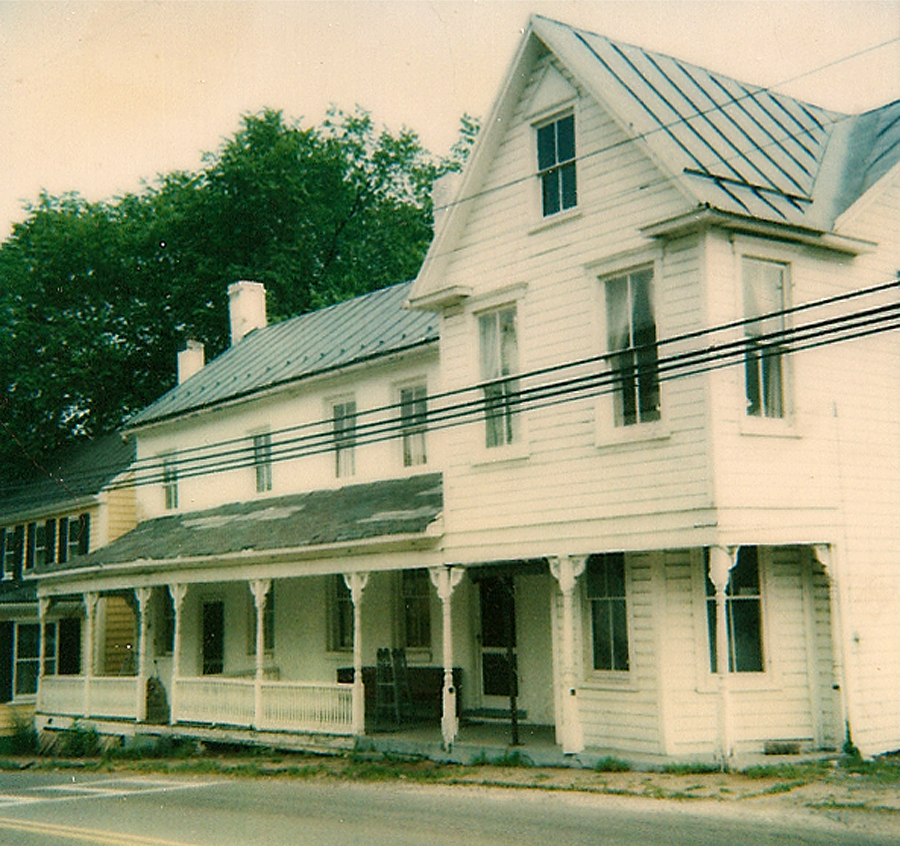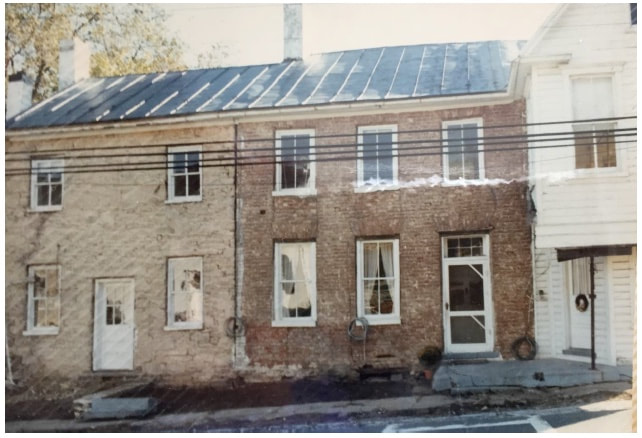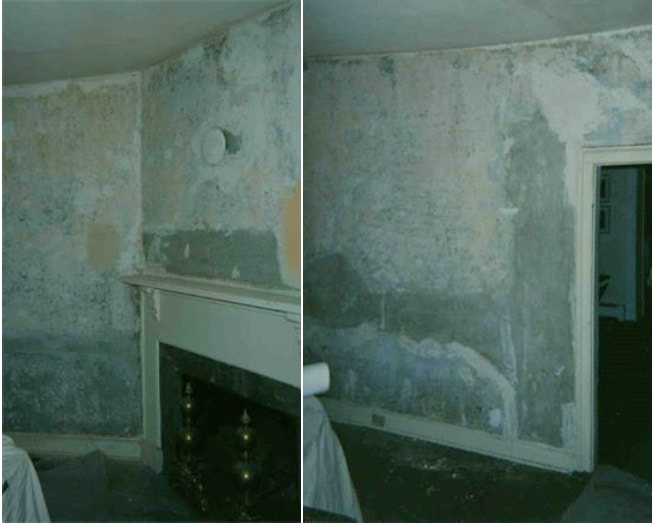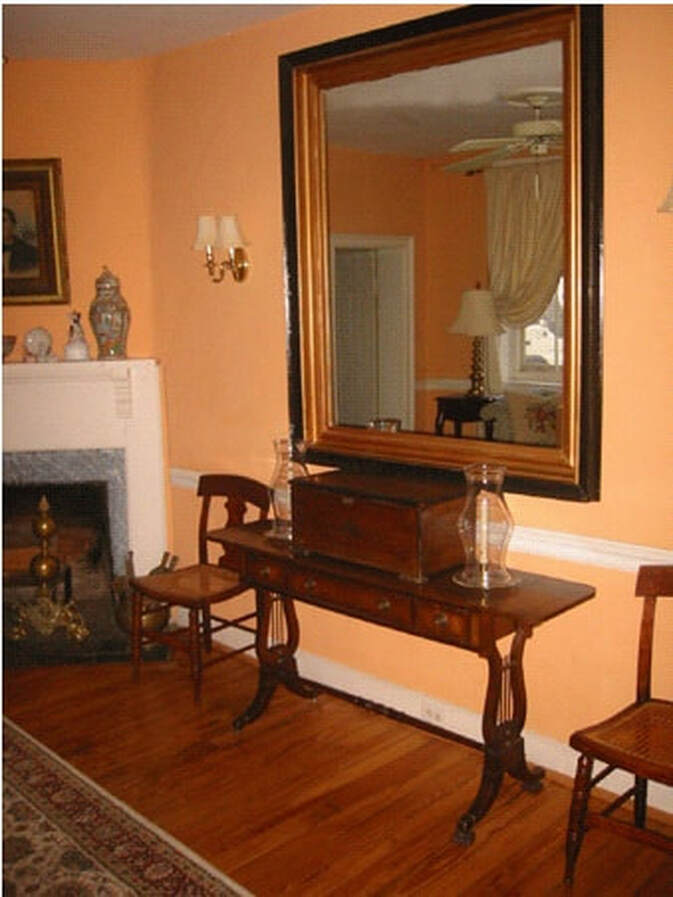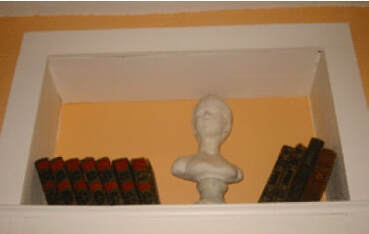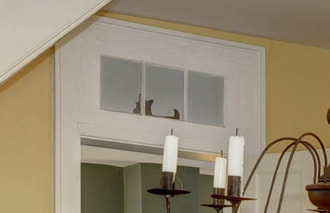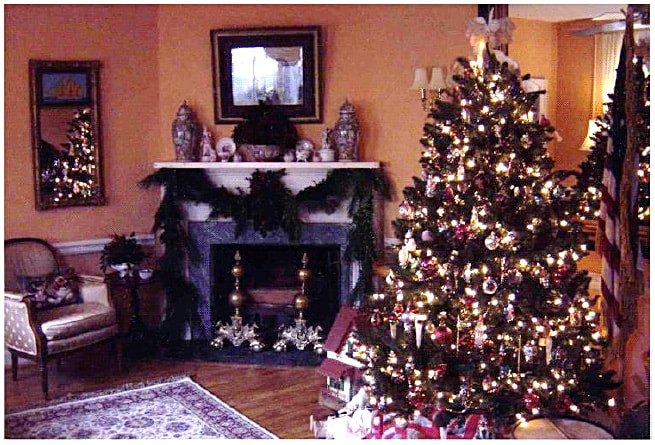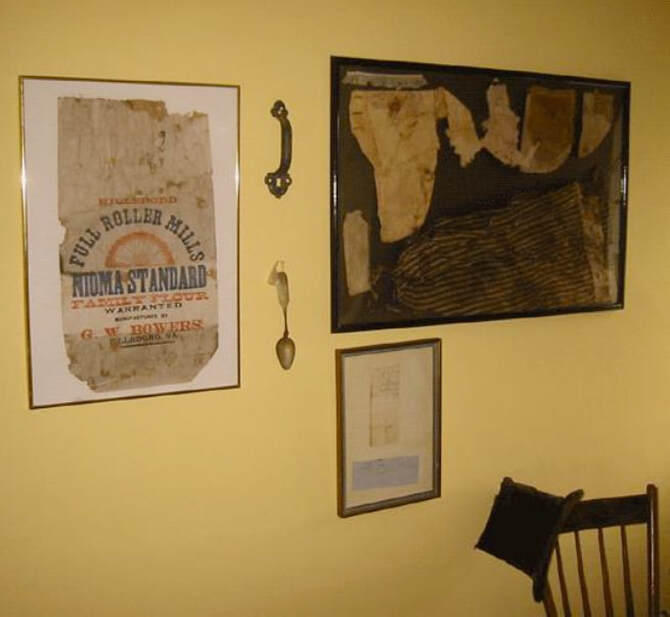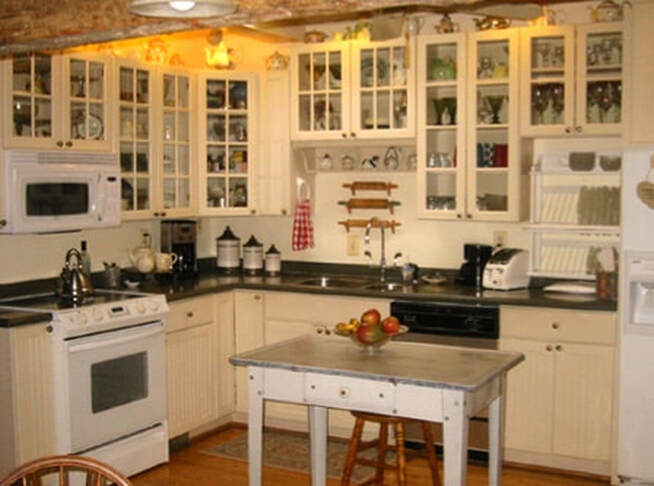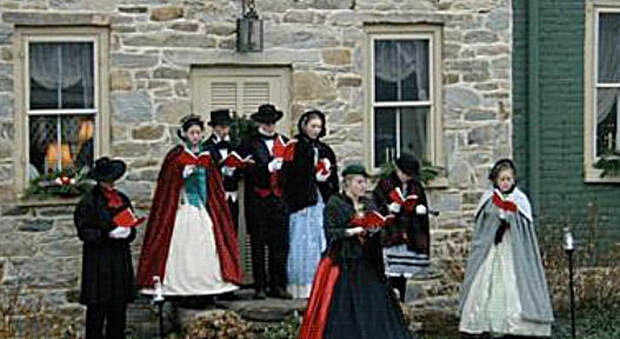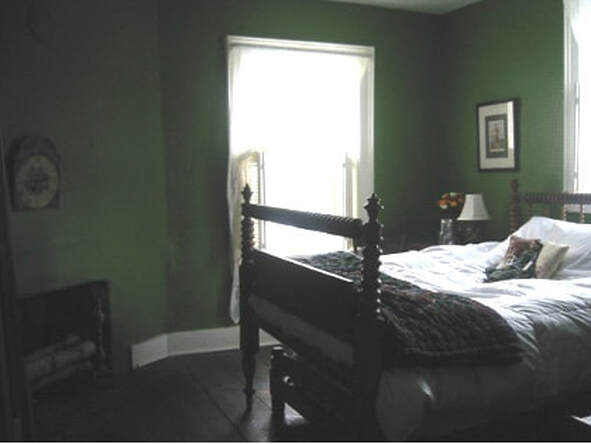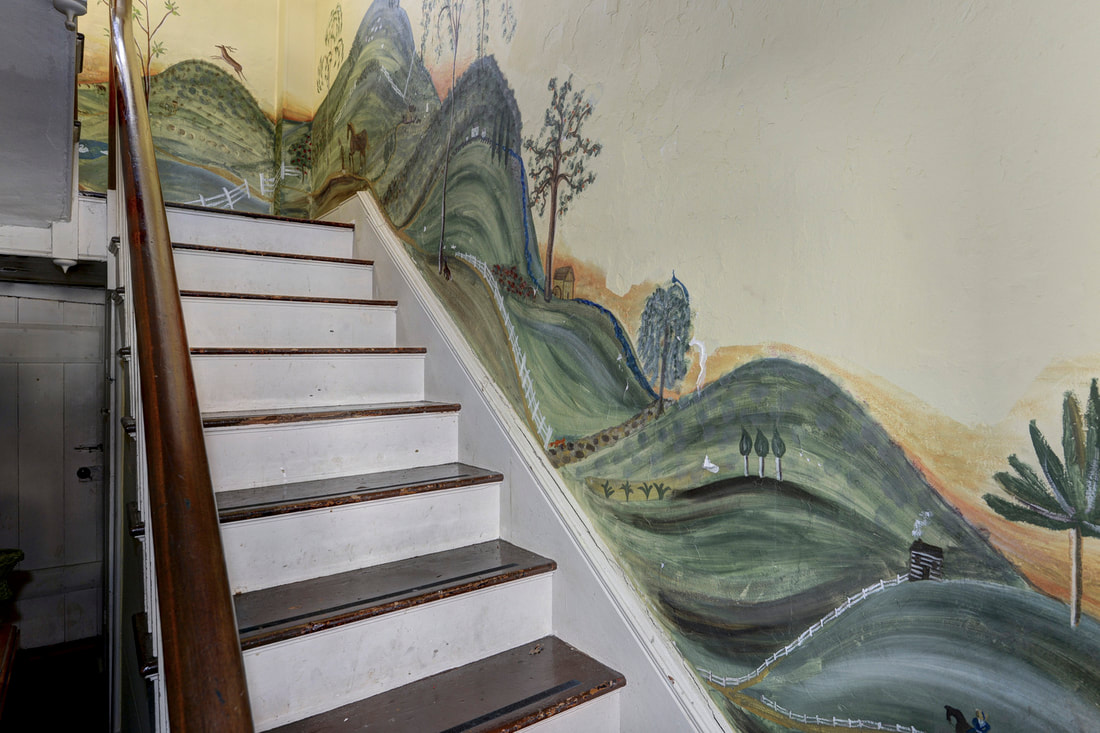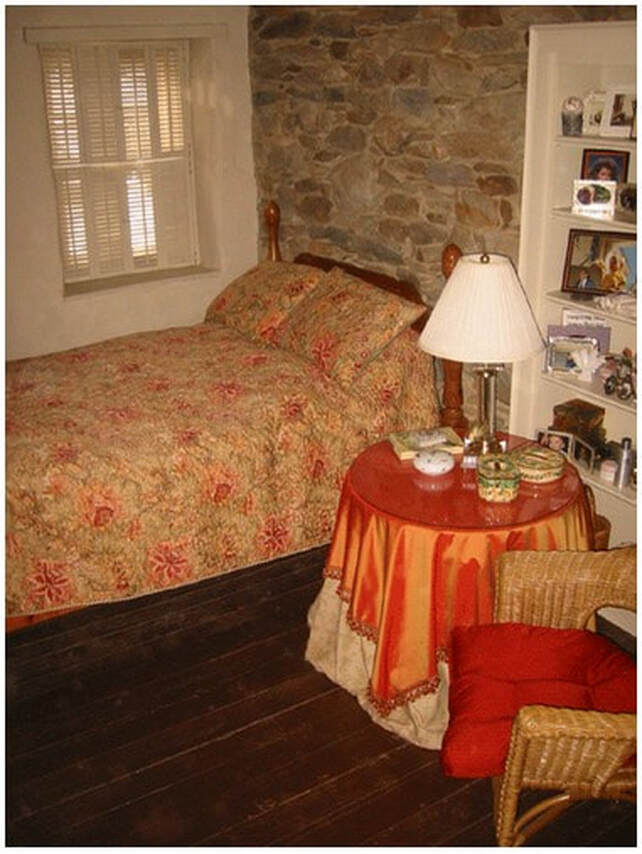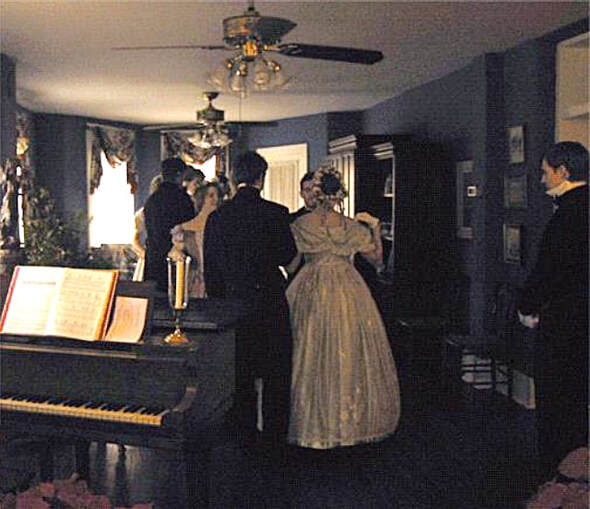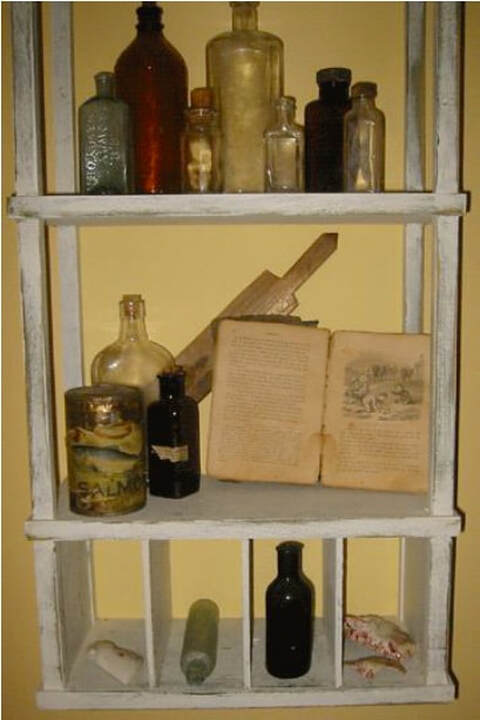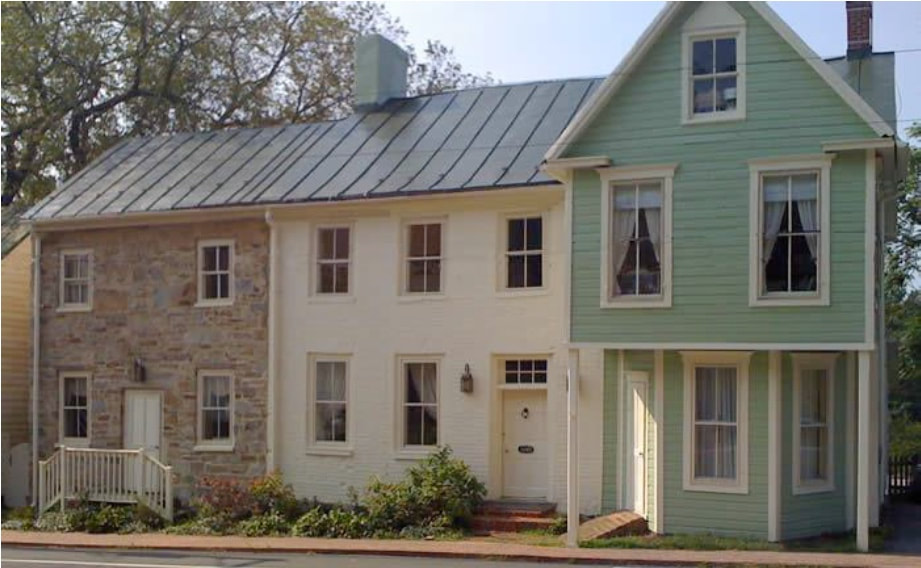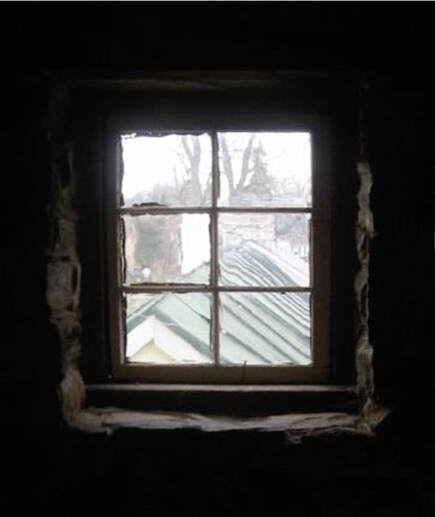FIRST, FIND A CHEAP TAVERN…As a "Better do this while we're young" married couple, in 1987, my husband, Chuck, and I took a leap of faith and purchased Birkett's Tavern in Hillsboro, Virginia. As you can see from the '87 photo above, we were either very brave or very stupid - likely both. But it was cheap. The original two-story structure of Flemish Bond brick (the center) was built by John Hough in 1819. We knew the date by looking in Virginia State Archives to find that the property’s real estate taxes went from zero to significant that year. In 1824, John Birkit, Sr. purchased the building from Hough and opened a tailor shop. And 16 years later - April 1840 - Birkett took a half day's wagon-ride from Hillsboro to Leesburg to acquire a license to operate an "ordinary" (a tavern) "from his home." And it's been known as Birkett's Tavern ever since. The Tavern stands on Charlestown Pike at the top and center of Hillsboro, Virginia. The middle section of the house (1820) is one of only two brick structures in the 19th century village. In the tavern's early days, there were at least three outbuildings: a long stone kitchen (revealed to us by an exposed stone wall inside the modern kitchen), a chinked-log smoke house (currently used for a garden and a tool shed), and one large outbuilding (Likely a barn to hold the horses of the guests). All that’s left of this barn is a stone foundation that sits a little under the sod and wooden sides bent at an angle that told you to stay out (it later made a fine bonfire). First job was to remove the decrepit porch roof that threatened to crush anyone who came to the front door. My husban Chuck, his brother Robbie, and my brother Lorenzo, stationed themselves on either side of the left hand overhang with ropes. Couple of us waited for traffic to clear, walked into the road, called “Pull!”, and in short order (really, really short order), the overhang fell into Charlestown Pike. Next few minutes were spent shoving the debris against the house before the next car came over the hill. Success! We took the pic of the house (seen below) after porch removal... and after we'd tapped a bit of old plaster from the stone and brick sections. Okay, okay - it was more than a bit of tapping. Anyway, we were getting somewhere! And now we knew no one was going to die attempting to knock on our front door (which we decided was the one in the brick section). Next up: tackling what we'd labeled the "front parlor" - the first room entered from the front door. THE ca. 1819 BRICK SECTION First we removed some truly hideous red and white wallpaper, and underneath we found the ghost of a chair rail, some markings from the original tavern bar, and evidence of all the various layers of 19th century milk paint - all the way down to the first coat, which had been a bright salmon color. We liked it, so we recreated the color as closely as possible. When we were done, we left an 8" square on the north wall - unpainted and behind a framed picture - so visitors could see the layers for themselves. The brick section has 1820 Rumford fireplaces. What the devil is a Rumford? This was a fireplace design by Sir Benjamin Thompson (Count Rumford) to maximize heat and space efficiency. Rumfords are built in the corners of rooms and have shallow depth and a curved back wall to distribute heat. Efficient, yes, but, wait! There's more! The fireplaces are built in the corners of rooms - two adjacent to each other on the first floor, and one in the corner of a room above and sitting directly over one of the corner fireplaces below. That made it possible to have the 3 chimney flues entwine as they were built upward. Nifty, eh? But since one of our chimney flues had collapsed, and we never had 10,000 bucks for the project, all 3 fireplaces remained decorative talking point. Further research on the house convinced us the front of the brick section was used for Birkett's tavern. And the adjacent Rumford fireplace was in the room behind it, which was probably the tavern dining area, because behind that room was the tavern kitchen. This tavern was very well-situated, as taverns go. It stood at the crossroads of Charlestown Pike and what was then the old road to Purcellville. That old Purcellville road lay straight down the tavern's west side (The current Purcellville Rd. - Rt. 690 - was built several doors down and east of the tavern at a later date). The ca. 1900 Frame Section The west frame section (on the right in the pictures above) was built on a shallow, wide and deep 19th century stone foundation. The clues to its the foundation's use began with the type of stone work: definitely ca. 1820-40. That and a few other hints, told us this was built for an early, wide and very deep covered porch. And why wouldn't you have a wide, deep porch along your tavern that could face the road to Purcellville? The hints that led us to this conclusion were our brick section's two "front doors"on the porch side - one from the parlor and one from the room behind it. How did we know they were doors to the outside? Dead give away was the transom windows (A row of windows above the door just like the home's front door on the Charlestown Pike). Of those 2 doors, the parlor door had been closed up, and the windows removed. Former owners turned into a shallow entrance closet, and we turned that window spot into a little display shelf: But it was the other door - the one that would have led from our Dining Room to that covered porch - that was the real give away: a complete 19th c. door with transom window intact, and the single row of glass panes indicated a secondary door (as opposed to the front door that held 2 rows of glass panes). Birkett's property used to encompass an eastern patch of land where a red barn stands today. The tavern keeper owned other properties, as well (Like the little stone house to its west which is the oldest structure in Hillsboro), and his total land amounted to around 12 or 13 acres. A typical early 19th century tavern required around 13 acres to support the business (Farmland for planting and pens to store animals brought through town by drovers). This was in the days before the trains, and there was only one way to get an animal all the way to the large markets of Alexandria: walk. By the way, the house's original hand-carved mantels, built-in corner cupboards and "9 over 6" pane windows were gone by the time we came. So, how do we know the house had them? In the 1930s, the government established the Works Progress Administration to create jobs for a very depressed American economy, and one thing they developed was the Historical Homes Study. Our home was lucky enough to be a part. This gave us clues on our restoration. For instance, we knew large brass locks had been removed by the time we got there - likely sold for their high value. These WPA reports can be found at Leesburg's Thomas Balch Library. We also learned that the original front parlor mantel was gone. In the WPA study, the mantel was described as having “a Federal-style medallion with crossed arrows and side pillars”. We found was a very simple affair. We did our best for it, though, dressed it up nicely at Christmas time and added some decorative trim later. As we were hunting for historic clues to the home, we decided it must have been a fine tailor shop. We found evidence under the attic floorboards: they include scraps of fabric, a 19th century woman's apron re-made from an old dress (likely Civil War-era), a front piece from a pair of ca. 1810-1830 breeches, various pockets, a portion of bonnet lace, and a flattened beaver skin top hat. At first we thought it was a rat skin, but then... few rats are oval. When pumped up with a wide rim of cardboard, lo' and behold, a very worn ca. 1830 beaver hat appeared. John Birkett's? Whoever the owner, he was right-handed: the brim is worn on the upper right edge. 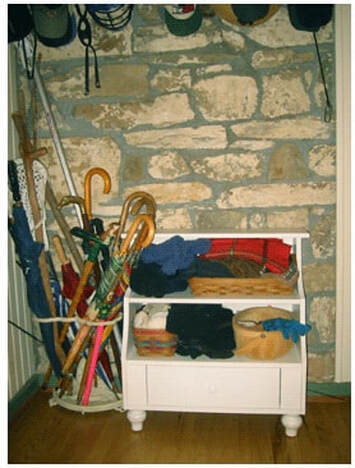 The Mudroom Wall - once the upper portion of the original 1820 kitchen wall. The Mudroom Wall - once the upper portion of the original 1820 kitchen wall. The framed receipts below the fabric scraps are a blue I.O.U., dated May of 1854 and signed by the then-Hillsboro resident Walter Friggins and written to Hillsboro Shoemaker William Fritz who lived across the stret. The I.O.U. is for the grand sum of 12 cents. Silly - until you realize a dozen eggs went for a penny, so the I.O.U.'s true value was around twenty or twenty-five dollars. But the long piece of paper above it is the true treasure. It has no date, but as a Civil War historian I can say unequivocally it was written during the war. From the top the note reads, "Samuel Arnit Dr." and below his name, a list: "87 pounds butter, 6.37; 66 pounds rags, .37, 74 chickens, 1.54; 64 doz eggs, 64." Then another of the same sorts of items for different amounts. Without question this is a list of items Union soldiers took from the tavern. The huge number of rags is the first tip-off (bandages were ever in short supply), but the sinker is the phrase "at 75 cents per hundred." Seventy-five cents on the dollar is what the federal government compensated civilians for goods taken by Union soldiers. We know the Union Army passed through Hillsboro on the way to Antietam in 1862, so it's highly likely this is when the goods were taken. Now, the town was decidedly Confederate, and half way through the war Confederates gave up the idea of ever getting anything back from the government - that is, unless they swore an oath of allegiance to the United States. So the owner - one of Mary's sons-in-laws - "filed" the worthless receipt on the attic floor of the brick section of the house - allowing us to pick it up and solve the puzzle 130 years later. We now resume our regularly scheduled program... The stone kitchen that once stood about 12' back from the house was about 25 feet wide and 12' feet deep. Why was it separate from the home? Well the roof can tell you: there fireproof slate shingles on it, while the main house shingles were wooden. It appears there was a "Dog Trot" - a passageway from house to kitchen - that led from the dining room of the tavern (Where we had our dining room). There is another door cut in this back wall which once led to an outside stairwell that went straight to the root cellar below the current dining room (this door is now set with removable shelves for an optional bookcase). While visitors can stand up in the basement rooms below the dining room and front parlor, the only current access to the root cellar is via a crawl space under the L-shaped back porch. In the basement under the front parlor sits half of a ca. 1850 wardrobe. It was a great place to tell ghost stories, because there are hints of a dark tale: During the Civil War, wood became scarce and coffins were always hard to come by, so tall wardrobes were often cut in half to use as replacements. There's a half a wardrobe lying in that cellar. I used to love taking our son's friends down there and have them sit on that wardrobe while I told them a few ghost stories. I would end by telling them the other half of their "bench" probabaly sits in a Hillsboro cemetery. Highly effective. Another interesting item which can be seen and gotten to from the crawl space is the lower half of the original kitchen's stone fireplace. The fireplace is five feet wide and four feet high, but, because the kitchen floor was raised three feet above the original dirt floor kitchen, the fireplace in no longer accessible. It rests behind the back wall of the large kitchen pantry. But the outside of the fireplace chimney stands in the north wall of the back workroom. A portion of the old kitchen wall an stood in for our mud room - just inside the back porch. In the 1940s, the store was turned into three apartments, and in the 1970s, Mr. and Mrs. Hoff purchased the property and turned it into a home. The Hoffs created the modern kitchen (below) by raising the kitchen floor to the same level as the rest of the house. Although the kitchen has nine-foot tall ceilings, there is one low beam: the evidence of a once a much higher ceiling beam for the dog trot. The stone kitchen foundation is easily mapped by visiting the crawl space underneath the existing kitchen. We renovated the kitchen again in 2000. PART II: OF STONE AND FRAME The stone section was added to the house in 1840 (Evidence: taxes on the house made another significant leap in 1839). This was around the time Birkett opened his tavern doors. No doubt he needed an extra tavern room or extra storage. Leesburg Court House records note the cost of the bond to run an Ordinary was $150.00 (If you ever look through Loudoun County, VA records, keep in mind that the town of Hillsboro is usually listed separately in the back of these record books (all entries are alphabetical - look under "Hillsboro"). An 1856 post-mortem inventory of Birkett's Tavern and home are found in Loudoun County Court House records. Several kegs are listed, along with half a dozen tavern tables and bedsteads. It also lists the debtors to the tavern-keeper - which began on the day - perhaps even the minute - the tavern opened. Soon Birkett's Tavern became known as Birkett's Hotel. In that day, a "Hotel" like Birkett's slept several men to a bed, and a drover's animals - be they goats, cows or sheep - would be kept in pens on the property (or on one of Birkett's many other tracts of land). Easiest to manage were the flocks of turkeys: the drovers just encouraged them to flap up into the nearest tree to bed down for the night. His tavern guests must have feasted on fresh oysters from the Canal boats at Harpers Ferry, because we found hundreds of oyster shells in the backyard. Then there were all those kegs of course. A few good beers might have helped a man sleep through a crowded, smelly, noisy night with strangers - not to mention the noise from flock of turkeys in the nearby tree. Hillsboro's Charlestown Pike (Route 9) fed into the Leesburg Pike (Route 7) - the main road that led straight to the docks at Alexandria. After Hillboro, a drover would walk a day and stop at Dranesville Tavern. They could make it to Alexandria by late afternoon the next day. 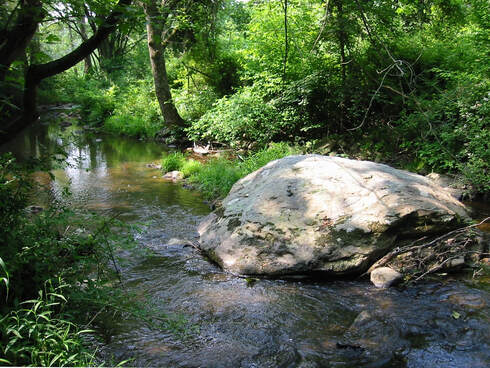 Known as Zikpha's Rock, we believe her cabin stood nearby, and this was where Zilplha, a free woman, did laundry for customers. Known as Zikpha's Rock, we believe her cabin stood nearby, and this was where Zilplha, a free woman, did laundry for customers. But Birkett and his family were not the only people managing this busy place. The 1850 slave census of Loudoun County lists John Birkett as the owner of seven slaves - a woman in her thirties and six children ranging from 2 to 17. It is likely the slaves lived in the upper room of the west stone section of the house and that the first floor area was used for tavern storage (large hand-hewn nails are still there on the open beams). One indicator was marks of an outside stairwell to the west loft. In the second story, there are marks on the decaying, original ceiling plaster (now removed) which indicate the space was divided into three rooms with a hole cut in one wall for a stove. That one wall is still standing and now separates the bedroom from the hall stairwell. The wall is made from pine boards - some of them 18" wide - that are simply no longer available anywhere. Prior to 1870 (when the stair well was built in the stone section), the only access to the upper rooms was by a stair on the east end of the house - typical of slave quarters. "Masters" separated themselves from "servants." The outdoor stairwell is long gone, but the doorway is now visible (and became a bookcase), and the pre-Civil War door (found by the current owners under plaster) was restored by John Ware, Jr., Stonehedge Restoration of Hillsboro, and serves as a closet door in the upper stone room. For more information on Black American history of Hillsboro and Loudoun itself, visit my other blog, "The Slave and Free of Hillsboro, Virginia". The slave history of Hillsboro was not known or recognized when we first moved there. In fact, the Hillsboro History pamphlet that existed then made no mention of them at all. When I asked why, I was told there were no slaves in Hillsboro! As an historian, I knew that was incorrect and determined to do the research and find the truth. An established fact in Loudoun is that the Quaker towns had residents that were known to help slaves escape to freedom. But they weren't the only pro-Union people in Loudoun when the Civil War began: the sons and fathers of Quakers and German farmers formed Virginia’s only known Union troop – the Loudoun Rangers. Hillsboro was a town of commerce and almost entirely Confederate. These farms and businesses were run with the labor of Loudoun County slaves, and their history must be recognized. I found the slave census for Hillsboro by visiting Leesburg's Thomas Balch Library. It wasn't easy. The entire book was alphabetical by owner, but cities were listed by themselves at the very back. I've since learned the majority of Hillsboro’s slaves lived on the ridge of the south hill. Although I haven't walked up there, a local historian and townsperson said evidence of their log cabins are still there. One of the stories I found during my research was that of Zilpha Davis, a freedwoman of Hillsboro who lived down by Catoctin Creek. Read her story. In 2019, Hillsboro United Methodist Church finally marked the slave cemetery. Now measures are being taken to protect their grounds. It should be noted that, although their slave cabins are disappearing, the stone and brick homes we enjoy today were built by their hands. For an overview of Hillsboro's Black American History, visit Hillsboro: African American Communities / History of Loudoun County, Virginia, and to further research Black American Loudoun County history, find the references listed at the end of this blog post. 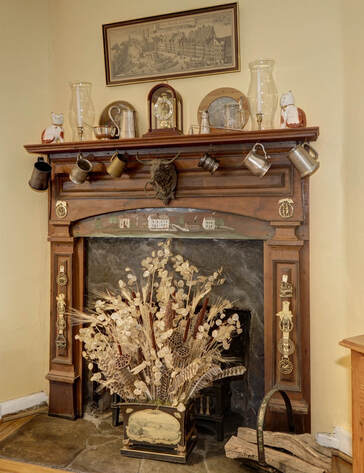 Part of the joy of renovating the home was to try to create looks that were appropriate to the time. For me, that meant painting the walls of the east stairwell (above) in the Limner style. Limners were 19th c. traveling artists who'd come into a town and take commissions to create quick portraits or decoratively paint a parlor or dining room wall. The techniques used counted on quick work (milk paint is fast drying), and to really save time portrait artists often painted the bodies of unknown future patrons and simply filled in the heads on the spot. Keeping the Limner tradition of working as quickly as possible, I finished the wall painting in a day and a half. I also painted the faux marble on both downstairs fireplaces, and created a primitive pictorial of Hillsboro ca. 1850 on the dining room mantel at right. This mantel has been dated to 1850 but was not original the house. We bought the mantel (sans top shelf) from the former owners, installed it ourselves, added the mantel shelf and stained it to match the rest of the piece My mother, Maxine Bean, had been an interior designer and came to live with us after my father passed. She helped us make a boatload of design decisions. She had the second floor bedroom in the stone secion seen below, and chose to have the far east wall plaster removed to reveal the beautiful stone work. The stonework was then re-pointed, and a small stairwell was built to give access to a loft over the bedroom hall - an excellent writer or painter's garrett or playroom. By the way, after Birkett added this 1840 stone addition, he apparently wanted the house to look "all of a piece," so he decided to plaster the entire house (brick and stone) and keyed it to look like blocks of marble (George Washington used exterior wood panels to simulate marble blocks at Mount Vernon). Each block was then "marbleized" with streaks of gray paint. You can see why I wanted to try the limner style... When we purchased the house, the plaster was already irreparably damaged. So we made the hard decision to remove it from the stone and brick sections. Until then the brick section had never been painted, but we were told by more than one restorer that paint would be the safest way to protect the old brick. Birkett died in 1854 and was buried in Hillsboro's Arnold Grove Cemetery. Court records note the 1876 court order that forced the sale of the house. Apparently Mary remarried within a year after John's death. Her new sons-in-law ran the tavern during the Civil War, but after the war, it began to "gather dust." "Birkitt's Hotel in Hillsboro" was put up for public auction in1876 and sold for $1,000 to one Lydia Hough (Likely Lydia was related to John Hough, the original builder). Around the turn of the last century, the owners added a frame section to the west end of the home. At that time virtually all of the old windows were replaced to match the addition. Gone are the 9-over-six windows with bubbled glass (except for one remnant in the back work room). Now all the houses are set with tall Victorian window panes, 2-over-2. The frame addition became a general store in the early 20th century. When we moved in, the floor of the long room had been painted, with the exception of a large rectangle of in its center - probably where the store's central cabinets sat. Previous Hillsboro residents remembered "The Weller Store", and folks could set their clock by Mr. Weller's 7 p.m. closing time. In summer months, he sold ice cream from the front bay windows (See below at the back of the room). Former Hillsboro resident Lucy Roederick once said, "You could get everything at that store - even bananas!" We re-finished the floors, and suddenly the long wide room was perfectly suited for a Victorian dance.... PART III: TREASURES, DEEDS & 1930 ADDITIONS During all the years we were there, we just kept finding treasures! WE found hand-blown marbles (Yep. They aren't round), Victorian paper dolls, and an 1870s children's school book. The book was probablyt issued by Hillsboro's first public school, the 1874 Arnold Grove Academy - now known as Hillsboro's Old Stone School. And then there were china and pottery shards and all those oyster shells!. And up under the 1870 stairwell in the stone section (in a space we were trying to clear for wiring), we found a ca. 1917 flour bag from the flour mill that once stood at the west end of town, and in it were three items: a medicine bottle, an empty can of salmon, and a whiskey bottle. Perfect bag lunch! 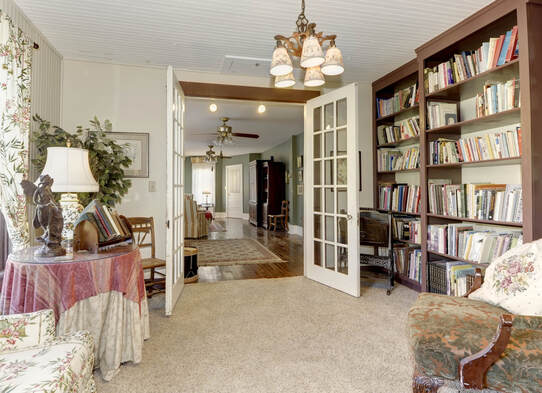 The Library. My brother, Lorenzo Bean, and my husband created seven built-in library shelves throughout the house, including library and office shelving in the 1930s section. The Library. My brother, Lorenzo Bean, and my husband created seven built-in library shelves throughout the house, including library and office shelving in the 1930s section.
TRACKING THE DEED The tavern deed is easily traced back from its modern owners, but there was a gap in the deed track - a chunk of empty space in the records between 1874 and 1928. I happened to be volunteering at the Thomas Balch Library, cataloging entries from local newspapers, when I ran across a small advertisement: a notice of the sale at auction of "Birkitt's Hotel in Hillsboro" in 1874. It was sold for $1,000 to one Lydia Underwood. Having finally found this connection, I was able to easily trace the deed up to 1928 through the records of wills and deeds, and so the deed track is complete (Lydia Underwood gifted the tavern to Joseph Underwood in her will which went into effect in 1878, and Joseph willed the tavern to Harriet Underwood in 1893). An interesting piece of history is the forced sale of the Tavern in April of 1874: Birkit [sic](Defendant), S.P. et al vs Reed, Harman et ux,â" of the Chancery Index 1875-1940 (No. M 3533). The chancery case lists "John and Mary Birket" at the top of the page, then says Mary died intestat, "leaving no personal estate and but a small lot of ground in Hillsboro Loudoun County Virginia some 50 x 22 feet on the main street of aforesaid town and leaving no debts or liens so that said lot descended to her heirs at-law to writ your oratrix and Susan Birkit who has married D.M. Divine. Margaret - the wife of Wm. Allder. Sallie - the wife of J.W. Price. Cornelia - the wife of Wm. A. Baker (said Cornelia is insane). S.P. Birkit and John Birkit and Wm. Birkit - who is dead leaving a widow - Margaret Birkit - and children. It went on to say the lot couldn't be split, so he (Reed) demanded they sell. The case was settled and "Birkett's Hotel" was sold at public auction to Lydia Hough. For more information on Birkett's Tavern, marriages, deaths, censuses, town history, or Loudoun history, please contact The Thomas Balch Library, Leesburg, VA 20175 or visit the Loudoun County Clerk's Office. THE 1930s SECTION Yes, it looks smaller from the street, but the home is actually quite large. The back of the house was added some time in the 1930s or 40s, probably in order to support the store - much like the stone section for Birkett's Tavern. Chuck and I restored these rooms one by one, and they now contain a library, full bath, and office. We left one room in the house unrestored: the back storage/workroom. 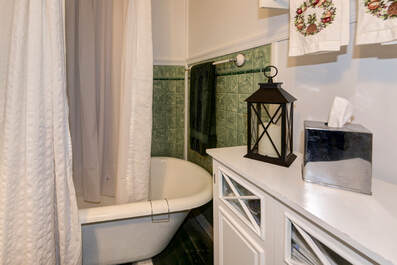 And, off the library, one finds the most valuable item in the entire house: the original full-flushing toilet. Plumbers have offered to buy this gem of a fifteen-galloner from us, but we wisely refused. The bathroom once had layers of grimy linoleum, cracked and peeling false tiles linoleum wallpaper, and a claw foot tub... with no claw feet. After our renovation, it had a painted wooden floor, the same wallpaper in excellent shape (the addition of a chair rail above hid a multitude of cracks and tears), and four pedestal feet for the tub courtesy of my brother, Lorenzo Bean. THE YARD In 1999, we added a back porch off the kitchen and stone sections. One reason we put it there is because we'd found evidence of a porch along the south wall of the stone section: the original v-grouting stopped below the threshhold of a back door. We assumed if there were only stairs at the door, the v-grouting would have continued down to the ground on either side. Instead there was a clear line across the stonework. 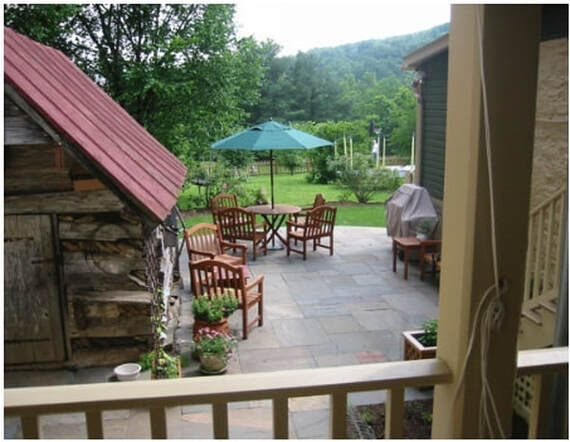 South view from the back porch. South view from the back porch. Also, up around the second story were two metal flanges - leftover supports for a back porch roof. We hired carpenter Paul Pronske to create a Hillsboro-style porch, so he based the railings and columns on a home that sits across the street. And, while the original back porch apparently only attached to the stone section, we chose to create an L-shape porch in order to make it possible to walk on to the porch from the kitchen. A stone patio completes the sideyard. Whe we left, Birkett's Tavern had a third of an acre, all fenced in and, beyond the back stone patiom we had a garden set with old-fashion roses - the ones with scent.. And there were peonies, lilacs, wisteria, and Butterfly bushes, alongside Hawthorn, Magnolia and Water Elms. Then, at the front of the house, we placed Double Lace Cap Hydrangeas whose magnificent flowers and changing hues caused curious individuals to knock at the front door and ask about them. And on that note, we end. our tale and say may Birkett's Tavern long stand and continue to delight all residents, visitors, and passersby alike. Of Slave and Free...
Further research on Black American History of Loudoun County, Virginia can be found at
Other References
5 Comments
6/15/2020 07:20:33 pm
What an accomplishment...all of the research and wonderful renovations. Thank you so much for sharing this terrific recording of what you achieved.
Reply
Meredith
6/16/2020 08:56:47 am
Thank you so much, Charla! Truly the experience of a lifetime.
Reply
11/19/2020 02:38:10 am
great work man i would like to congratulate you on this effort
Reply
Leave a Reply. |
